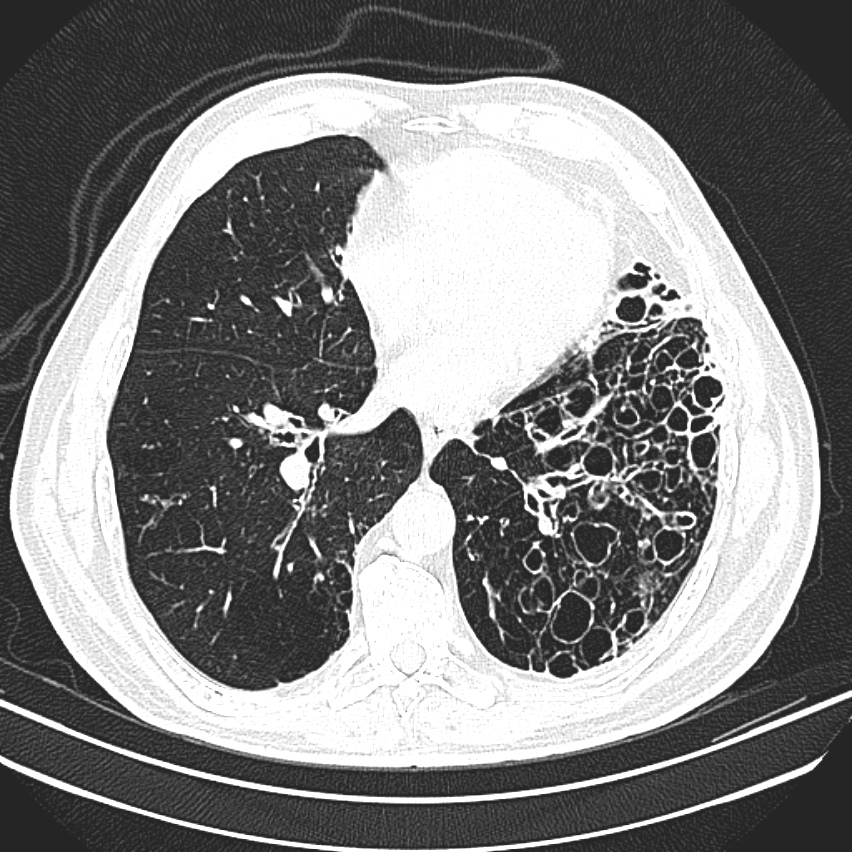Primary ciliary dyskinesia CT scan
|
Primary ciliary dyskinesia Microchapters |
|
Differentiating Primary ciliary dyskinesia from other Diseases |
|---|
|
Diagnosis |
|
Treatment |
|
Case Studies |
|
Primary ciliary dyskinesia CT scan On the Web |
|
American Roentgen Ray Society Images of Primary ciliary dyskinesia CT scan |
|
Risk calculators and risk factors for Primary ciliary dyskinesia CT scan |
Editor-In-Chief: C. Michael Gibson, M.S., M.D. [1] Associate Editor(s)-in-Chief: Hafsa Ghaffar, M.B.B.S[2]
Overview
Patients with primary ciliary dyskinesia (PKD) present with bronchiectasis or chronic sinusitis as the initial presentation which in turn leads to further testing and establishing a diagnosis. A High-resolution CT scan is the most sensitive imaging test to diagnose bronchiectasis but it can not differentiate between different aetiologies as bronchiectasis due to PCD vs Cystic fibrosis. HRCT can also interpret dextrocardia if present. If a chest X-ray in any patient is suspicious of bronchiectasis HRCT should be performed to rule out PCD.
CT scan
- The most sensitive imaging modality to diagnose bronchiectasis is high-resolution CT HRCT however, HRCT cannot distinguish bronchiectasis due to PCD vs other etiologies such as idiopathic, cystic fibrosis CF, post-infectious, etc. There are disease distributions that may support specific diseases For example; PCD may be linked to bronchiectasis with predilection in the middle and lower lobes, as compared with CF, which usually involves the upper lobes.Mild lung disease may start earlier in life, as HRCT scans of infants and children with PCD show sub-segmental atelectasis, peri-bronchial thickening, mucus plugging, the suggestion of air trapping, and ground-glass opacities.HRCT may show bronchiectasis even in infancy, and its frequency increases with age. The absence of bronchiectasis on an HRCT scan of an adult basically excludes PCD from the differential.[1][2][3]
- Dextrocardia if present on CT chest could be demonstrated as well and necessitates further testing.
CT Para nasal sinuses
CT scan of the sinuses may show changes associated with chronic sinusitis with opacification and polyps in some cases.
CT Chest Bronchiectasis
|

References
- ↑ Lobo J, Zariwala MA, Noone PG (2015). "Primary ciliary dyskinesia". Semin Respir Crit Care Med. 36 (2): 169–79. doi:10.1055/s-0035-1546748. PMC 4873960. PMID 25826585.
- ↑ High-resolution CT of patients with primary ciliary dyskinesia.Kennedy MP, Noone PG, Leigh MW, Zariwala MA, Minnix SL, Knowles MR, Molina PLAJR Am J Roentgenol. 2007 May; 188(5):1232-8.
- ↑ Primary ciliary dyskinesia in the pediatric population: range and severity of radiological findings in a cohort of patients receiving tertiary care.Jain K, Padley SP, Goldstraw EJ, Kidd SJ, Hogg C, Biggart E, Bush AClin Radiol. 2007 Oct; 62(10):986-93.